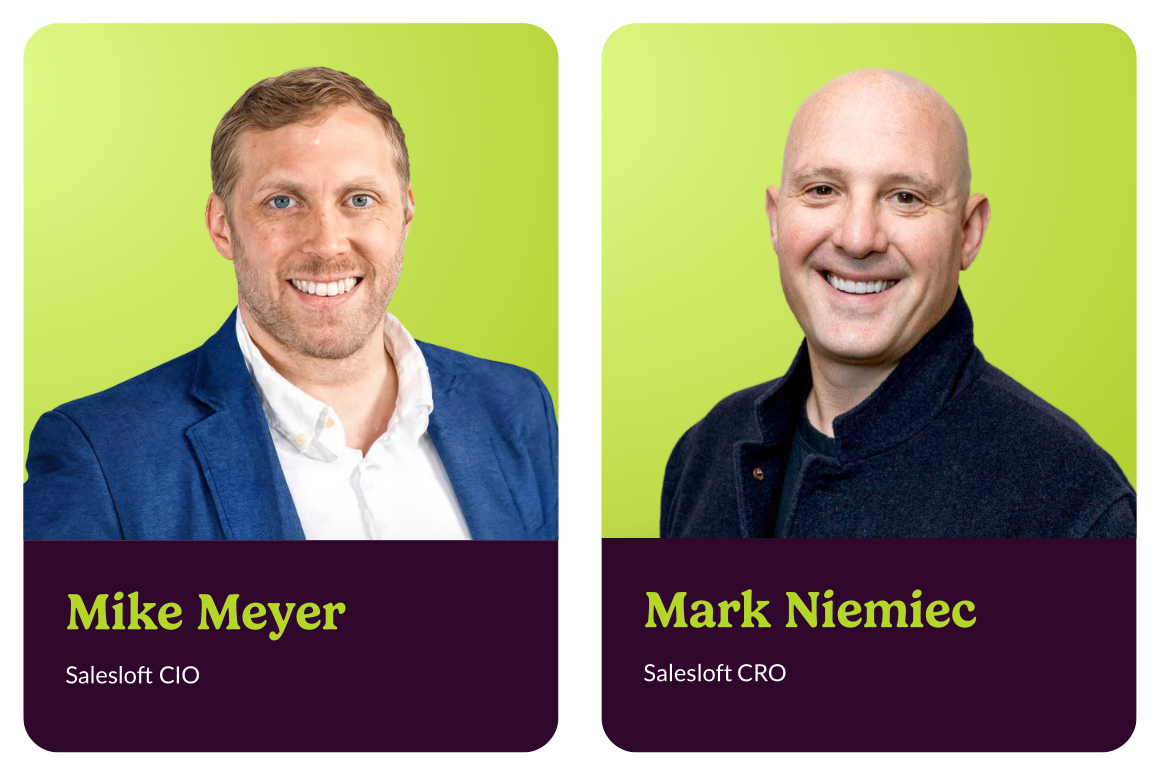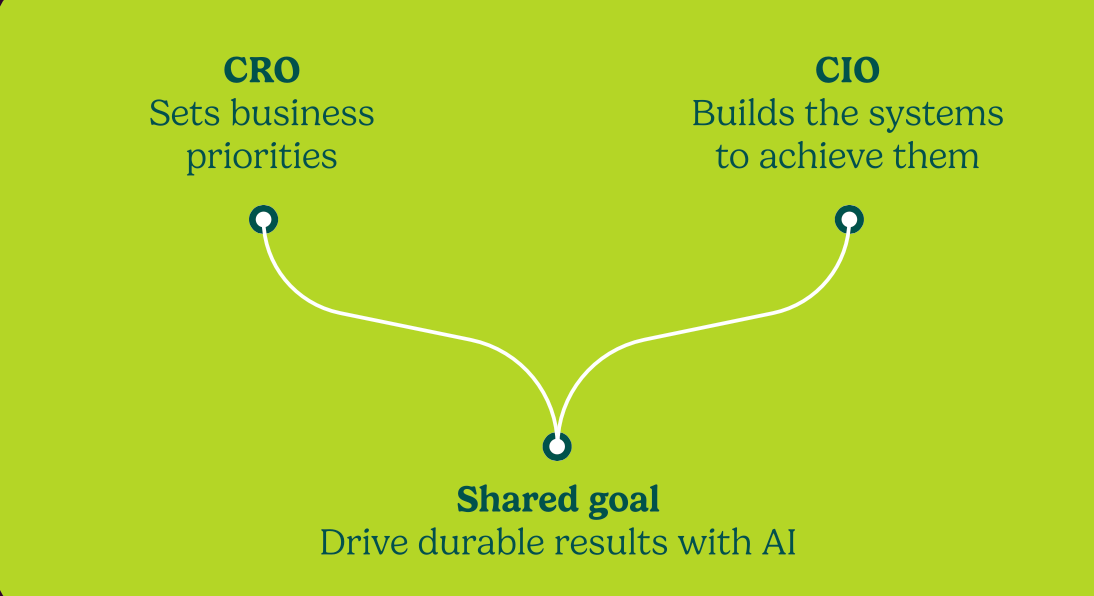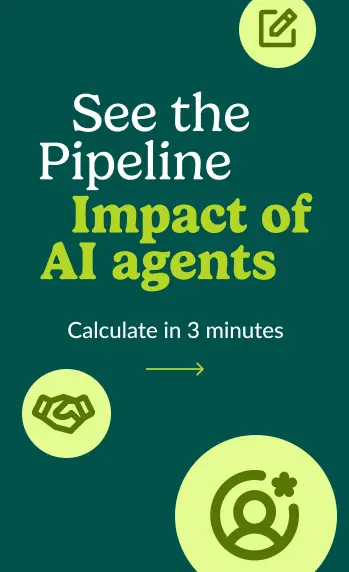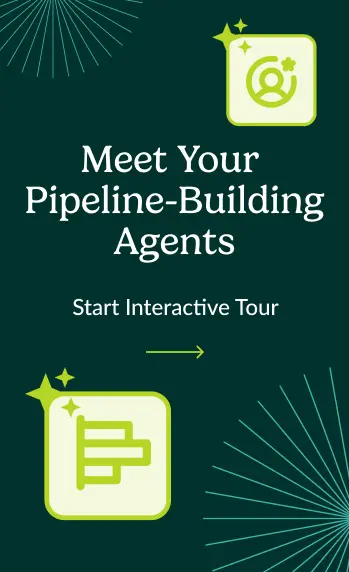The CRO + CIO Playbook for Revenue-Driving AI Agents
Published:

Get the green light faster from your CIO
Featuring proven tactics from Salesloft’s Information Security lead
Today, with CIOs leading 71% of enterprise AI initiatives, your revenue AI rollout won’t get approved if it doesn’t meet your CIO’s standards. But if you partner with your CIO from the start, you can unlock unprecedented durable revenue growth together.
This is your blueprint for making that partnership work.
Salesloft teams have seen how fast things move when revenue and IT align from the start. Mike and Mark share tips for revenue leaders to partner with IT leadership and work together to establish agentic AI that gives you a competitive edge.

In this playbook, you'll learn how to:
- Align with IT and security leaders from the start
- Operationalize AI directly inside seller workflows
- Move fast without breaking compliance
Keep reading to see how to join forces with your IT or tech leader to unlock AI's full potential — safely, scalably, and with real revenue impact.
Action 1: Start with partnership
The first step is shifting your mindset: your CIO is a partner, not a gatekeeper. They are your most essential partner in bringing AI to life.
CIOs are responsible for data security, policy enforcement, and vendor governance. But the best CIOs see themselves as enablers of business outcomes. Their goal is to ensure the systems you rely on can scale safely and sustainably.
CIOs are often seen as the ‘process police’ because we care about compliance and locking things down. But our job as technology leaders is to enable the business to achieve its desired outcomes through technology.
What CROs are solving for
- Reclaiming seller time
- Boosting pipeline and revenue
- Delivering faster cycles
- Scaling personalization
- Showing payback in quarters
What CIOs are solving for
- Enabling the business with technology
- Protecting customer data
- Policy enforcement
- Vendor governance
- System reliability
That’s why leading organizations are establishing AI governance committees. These cross-functional decision-making bodies drive adoption and reduce downstream risk.
Who’s who on a typical AI committee?
They set direction, vet use cases, define policy guardrails, and monitor rollout performance. Coauthorship accelerates trust. Approvals happen faster. Feedback loops are tighter. Everyone knows who owns what.
IT & Security — Oversees system architecture, data protection, and platform integrity
Sales Leadership — Defines business outcomes and AI use cases
RevOps — Owns implementation, workflow integration, and adoption support
Legal & Compliance — Ensures policy alignment, regulatory compliance, and risk mitigation
To do:
- Reframe the conversation from tool procurement to strategic transformation. Even the most advanced platform will stall without the CIO’s buy-in. But when CROs and CIOs approach agentic AI together, it becomes a durable and defensible growth strategy.
- Establish an AI committee with other key stakeholders.This cross-functional group should:
- Review and approve AI use cases and vendors
- Define agent behavior, boundaries, and policies
- Track adoption and impact across teams
You can’t treat AI like just another sales tool. You need the right team to operationalize it. The CRO defines the goals, but it takes the technology leaders, RevOps, and Legal partners to get it right.
Tip: you can find more information about this topic in our Revenue Leader's Guide to AI Transformation.
Action 2: Align on Strategy
Joint ownership starts with shared goals. A CRO might focus on pipeline velocity or seller capacity. A CIO might care more about vendor consolidation or governance automation. To achieve strategic alignment, you’ll need to define what success looks like for revenue and IT.
As a CRO, you need to be able to translate sales pain and requirements into IT priorities.
For example, say you want to reduce seller admin time. Your CIO will need to understand how the AI system will preserve data integrity, comply with governance policies, and avoid shadow tool behavior. It’s not about softening your case. It’s about showing you’ve thought it through.
Once you build your strategic groundwork together, you can approach the AI committee with aligned OKRs and a cohesive plan that gives you a running start for approval and implementation.

Revenue OKR | Aligned IT OKR |
|---|---|
|
|
|
|
|
|
|
|
To do:
- Learn to speak the same language as your CIO. That means translating revenue objectives into IT-ready terms. You don’t need to be fluent in governance and compliance, but if you show you’ve done the thinking and can meet the CIO halfway, you’ll move faster.
- Define mutual priorities. By defining mutual priorities — like pipeline growth for sales and system consolidation for IT — we’ve been able to launch and scale AI agents with clarity and control.
Joint ownership also improves rollout speed. When both leaders sponsor the effort, their teams are more likely to support integration, adoption, and feedback loops. AI becomes part of the way work gets done — not just a feature that needs promotion.
Action 3: Build the agentic foundation
Even the most advanced agentic AI requires the right groundwork.
Mike describes an agentic AI triad that any business unit must optimize and bring together for success with agentic AI: data, prompting, and action.
If you can get these three things in one place, your team is going to thank you. Because they are going to generate more pipeline, close deals faster, and ultimately drive more durable revenue.
Considerations for Revenue | Talking points for CIO collaboration | |
|---|---|---|
DATA | AI performance depends on access to timely, structured inputs. But sales data is often fragmented across CRMs, calendar apps, call recordings, and email. Without a unified system, governed by policy and access control, your AI will return incomplete results. And your CIO won’t approve a tool that scrapes sensitive data from multiple sources without oversight. |
|
PROMPTING | The system must reflect the way your sellers actually sell. A large language model by itself isn’t enough. You need a tool that’s tuned to the nuances of revenue work: understanding buyer behavior, stage progression, urgency, and persona. Off-the-shelf tools won’t recognize pipeline risk or coach reps effectively. |
|
ACTION | Agents only drive outcomes when they operate within the workflow. If sellers have to switch tabs to see insights, adoption will falter. Agents should prompt actions, surface insights, and act on behalf of your sellers from inside the systems they already use. Embedding AI into your workflow will help sellers stay focused and ultimately spend more time engaging with customers. |
|
To do:
- Optimize and bring together the agentic AI triad of data, prompting, and action. The organization needs shared ownership and the right foundation to make it scalable, governed, and effective.
- Maintain transparency and trust with a shared dashboard with audit trails and agent telemetry. IT will need to know which agents are active, what data they touch, and how controls are enforced. Revenue will want to see which actions drive results, where sellers struggle, and how adoption is trending.
CIOs are being very cautious and thoughtful about deployment because there are security, government, governance, accuracy, and performance issues that still need to be resolved.
Action 4: Operationalize the system
Once you have the foundation, it’s time to build your infrastructure. Salesloft uses a model called Revenue Action Orchestration, a closed-loop system that captures signals, applies reasoning, and triggers actions inside seller workflows.
- Capture: Captures signals from emails, meetings, CRM updates, and calls.
- Reason: Uses sales-trained AI to reason across urgency, persona, stage, and risk.
- Act: Takes action inside the workflow: assigning tasks, nudging reps, and updating CRM fields.

The more visible and governable your AI is, the sooner revenue and IT will see a return on investment. In our work with dozens of enterprise teams, we’ve found that time-to-value improves dramatically when the underlying AI follows clear rules.
Our AI is based on four clear principles:
These principles result in better adoption, cleaner data, and lower risk. Sellers save time and get direction, leaders gain accurate data without manual logging, and CIOs see explainable behavior inside a governed system.
1. AI accuracy
Unrivaled accuracy and relevance
Feel confident that seller actions drive revenue impact with insights derived from a robust data model comprising over 5B+ buyer-seller interactions.
2. Contextualized AI
Transparent and explainable
Always understand the “why” behind the recommendations the AI surfaces with in-product explanations, building trust in the AI model and in sellers’ own intuition.
3. Purpose-built AI
Drive impact where it matters
No more guessing: agents identify the right actions to take directly in the seller workflow, so you get to revenue outcomes quickly without disrupting a seller's day-to-day routine.
4. AI security
Industrial-grade protection
The world’s most security-conscious companies trust our AI to power personalized, adaptable buying experiences without compromising governance, control, or flexibility.

To do:
- Build a business-backed use case. What problem are you solving? What does it unlock for revenue? Think call summaries to reclaim seller hours or prioritization agents to boost pipeline velocity.
- Establish an architecture and integration map. Where does the agent sit? What systems does it touch? Where does the data flow? Who has access?
- Create a governance plan. Establish auditability, controls, and fallback mechanisms. Demonstrate that you know how to keep AI explainable and within bounds.
- Involve InfoSec from Day 1. Don’t wait until the contract’s on the table to ask for an InfoSec review.
- Avoid “just a pilot” shortcuts. Document oversight mechanisms from the beginning, including audit logs, scope limits, and rollback procedures.
Revenue teams don't have months to ramp
Salesloft delivers meaningful productivity, deal visibility and pipeline action within the first 10 days, so your team can focus on driving outcomes, not setup.
Get ahead of the "no" by partnering with your CIO
Every week, Salesloft hears from leaders who want to act on AI but are unsure how to start. The intent is there. The opportunity is clear. The hesitation comes from uncertainty around risk, oversight, and impact.
What I hear over and over from every technology leader I talk to is: ‘We want to take advantage of agentic capabilities, but we honestly don’t know how to go about it.’
We believe the best way to start is with a partnership. When CROs and CIOs develop a plan together, you can establish infrastructure to drive durable revenue growth for years to come. Because the platform matters, and governance matters, but what makes AI successful is the alignment between those who use it and those who approve it.
Salesloft builds AI agents that meet the expectations of revenue and IT teams alike. If you’re ready to explore what that looks like, get a demo (and bring your CIO along with you).





























